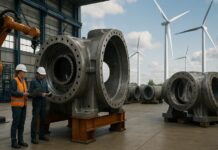Vestas has conducted a pilot study in cooperation with Windcat Workboats to investigate how the first hydrogen-powered crew transfer vessel (CTV) can assist in lowering carbon emissions from its offshore service operations.
The CTV is propelled by a dual-fuel system that can run on hydrogen in addition to marine gas oil. Since hydrogen fuel contains no carbon, it suggests a potential for substantially cutting emissions while maintaining a same level of power output. On July 15, the solution will be put to the test at the Norther Wind Farm in Belgium as part of a pilot programme. Through the programme, Vestas will have the opportunity to investigate the most scalable methods for integrating hydrogen into its operating setup. The trial’s goal is to learn more about the possible uses and practical limitations of hydrogen-powered ships.
Hard to reduce industries, like shipping, will be the last frontier in this worldwide decarbonization effort. According to Christian Venderby, Executive Vice President, Service at Vestas, hydrogen is a critical technology to advance this journey, so Vestas is excited to evaluate its capability to minimise emissions from its service operations. In comparison to a conventional vessel, the new CTV has the ability to save 158 tonnes of carbon dioxide, or about 37% more carbon emissions.
This vessel, created in collaboration with their sister firm CMB.TECH, provides the industry with a practical way to reduce service vessel emissions dramatically, a solution that is currently applicable to all wind farms. They can implement hydrogen technology in the market and jump-start further advancement of the technology, legislation, supply chain, etc. by adopting dual-fuel combustion engines. According to Managing Director of Windcat Workboats, Willem van der Wel, collaborations like these are what are needed to be able to expand this technology further, and they applaud Vestas for taking this initial step.
































